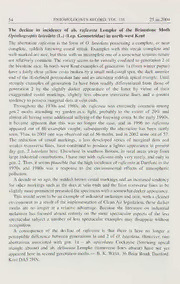
The decline in incidence of ab. ruficosta Lempke of the brimstone moth Opisthograptis luteolata (L.) (Lep. Geometridae) in north-west Kent PDF
Preview The decline in incidence of ab. ruficosta Lempke of the brimstone moth Opisthograptis luteolata (L.) (Lep. Geometridae) in north-west Kent
54 ENTOMOLOGIST'S RECORD, VOL. 16 25.iii.2004 1 The decline in incidence of ab. ruficosta Lempke of the Brimstone Moth Opisthograptis luteolatci (L.) (Lep. Geometridae) in north-west Kent The aberration ruficosta is the form of O. luteolata possessing a complete, or near complete, reddish forewing costal streak. Examples with this streak complete and well-marked are rare, but those with an incomplete one of a somewhat tenuous nature are relatively common. The variety seems to be virtually confined to generation 2 of the bivoltine race. In north-west Kent examples of generation la (from winter pupae) have a fairly clear yellow costa broken by a small mid-costal spot, the dark anterior end of the ill-defined postmedian line and its attendant reddish apical triangle. Until recently examples of generation la have been readily differentiated from those of generation 2 by the slightly darker appearance of the latter by virtue of their exaggerated costal markings, slightly less obscure transverse lines and a greater tendency to possess marginal dots at vein ends. Throughout the 1970s and 1980s, ab. ruficosta was extremely common among gen.2 moths attending my garden m.v. light, probably to the extent of 20% and almost all having some additional sullying of the forewing costa. In the early 1990s, it became apparent that this was no longer the case, and in 1996 no ruficosta appeared out of 86 examples caught; subsequently the aberration has been rarely seen. Thus, in 2001 one was observed out of 56 moths, and in 2002 none out of 57. The reduction of costal markings, a less developed series of marginal dots and weaker transverse lines, have combined to produce a lighter appearance in present day gen. 2 luteolata here. Elsewhere in southern Britain, in rural areas away from large industrial conurbations, I have met with ruficosta only very rarely, and only in gen. 2. Thus, it seems plausible that the high incidence of ruficosta at Dartford in the 1970s and 1980s was a response to the environmental effects of atmospheric pollution. A decade or so ago, the reddish brown costal markings and an increased tendency for other markings such as the dots at vein ends and the faint transverse lines to be slightly more prominent presented the specimens with a somewhat darker appearance. This would seem to be an example of industrial melanism and now, with a cleaner environment as a result of the implementation of Clean Air legislation, these darker moths are no longer at a relative advantage. Because the literature on industrial melanism has focused almost entirely on the more spectacular aspects of the less spectacular subject a number of less spectacular examples may disappear without recognition. A consequence of the decline of ruficosta is that there is here no longer a perceptible difference between generations la and 2 of O. luteolata. However, two aberrations associated with gen. la - ab. apicolutea Cockayne (forewing apical triangle absent) and ab. delineata Lempke (transverse lines absent) have not yet — appeared here in second generation moths. B. K. West, 36 Briar Road, Dartford, Kent DA5 2HN.
